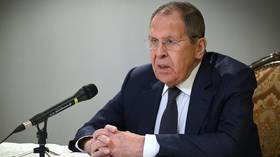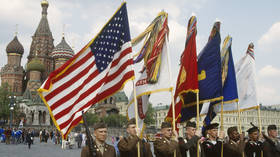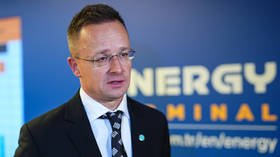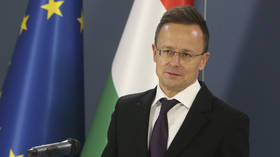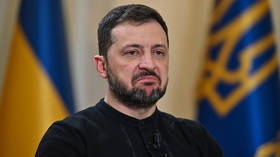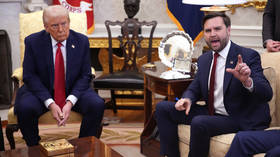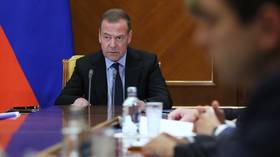American taxpayers have now spent more than ONE BILLION dollars on arming Ukraine. But are they getting value for their money?
In recent months, NATO forces have doubled down on their stand-off with Russia, with Ukraine at the epicenter. Massive military exercises are roaring ahead in Eastern Europe which only seem to be making the situation more tense.
The escalations kicked off in May with the colossal DEFENDER Europe drills. That show of firepower saw 28,000 troops deployed across the continent. Now, months later, a new row has been ignited after a British warship, the HMS Defender, crossed the border into Crimean waters in the Black Sea. This was in addition to a similarly fractious exchange between the Dutch Navy and Russian fighter jets in the same area, off the coast of both Russia and Ukraine.
Military support for Kiev has become a mainstay of US foreign aid policy to the tune of over one billion dollars since 2014. Washington has consistently set a goal to fund the Ukrainian Armed Forces with a view to bringing them in line with NATO standards.
Last month, POLITICO reported that the US government was freezing further military aid to the Eastern European nation, suspending exchanges worth up to $100 million. The move follows Russia’s drawdown of military forces near the Ukrainian border and what was widely hailed as a productive summit between US President Joe Biden and his Russian counterpart, Vladimir Putin. Shortly after the story broke, Biden’s spokesperson-in-chief, Jen Psaki, released a statement saying that “the idea that we have held back security assistance to Ukraine is nonsense,” while insisting that the US has prepared “contingency funds in the event of a further Russian incursion.”
Also on rt.com Ukraine has surrendered itself to control from West, no point in meeting Zelensky when decisions are made in Washington – PutinThough the statement did not disclose the amount of these contingency funds, it could well refer to the $100 million that the White House has purportedly put on ice. Instead of withholding the cash, the argument goes, it is being saved in case circumstances change.
Whatever the case may be, continued American funding for Ukraine seems all but certain. In light of recent events and a US-Russia relationship that is beginning to show signs of restoration, the colossal aid package is now under greater scrutiny than ever before.
Cash for Kiev
Since 2014, the US has delivered around $2.7 billion in aid to Ukraine, according to USAID data. A significant portion of the total amount, approximately $1.3 billion or 47%, was handed out by the Department of Defense (DOD). USAID lists total aid for 2020 as only partially reported, and very little data is available for Fiscal Year 2021. That said, in March 2021, the DOD announced a $125 million defense package for Kiev, followed by another $150 million announced in June.
One avenue of DOD aid to the country is so-called Foreign Military Financing, or FMF, which is a program that provides government funds to nations for use in the US military-industrial complex. Specifically, the funds are used to purchase “US defense articles, services, and training.” In addition to FMF, Ukraine also receives aid via the Ukraine Security Assistance Initiative, which aims to “enhance the capabilities of the military and other security forces of the government of Ukraine to defend against further aggression” and “to assist Ukraine in developing the combat capability to defend its sovereignty and territorial integrity.”
Also on rt.com EXCLUSIVE: Amid ‘political repression,’ Ukraine becoming American ‘colony’ in Europe, says sanctioned opposition leader MedvedchukMore specifically, the initiative provides the country’s armed forces with lethal assistance such as “anti-armor weapon systems, mortars, crew-served weapons and ammunition, grenade launchers and ammunition, and small arms and ammunition,” as well as non-lethal intelligence support in the form of radar technology, surveillance drones, and equipment geared towards enhancing Ukraine’s cyber capabilities.
Are Americans getting bang for their buck?
The stated long-term objective of US military and security assistance to Ukraine is to prepare it for membership in NATO. However, in reality, the country has taken almost no significant steps towards joining the bloc in the last several years. Calls from senior officials in Kiev to pave the way for it to sign up appear to have fallen on deaf ears in Washington, with a number of other member states understood to have serious reservations about the prospect.
That, however, hasn’t stopped American government officials using NATO membership as a pretext to send cash to Ukraine, in the hopes of keeping it firmly within the US sphere of influence. While the country might not be part of the club anytime soon, it is a convenient proxy in hostilities between the US and Russia.
Aligning the country’s defensive capabilities with those of the bloc and “improving interoperability with NATO” serve to guide Ukraine towards an eventual Membership Action Plan to join the American-led group. There is plenty of evidence showing the destabilizing effect that NATO encroachment has on relations between Russia and the West, and how enlargement of the military bloc has forced Russia to adopt a defensive position.
Be that as it may, if the US continues to provide assistance to Ukraine without bringing an end to the ongoing conflict in the Donbass region of Eastern Ukraine, it is unlikely that other members of NATO would back offering membership to Kiev, given it could only further escalate tensions in the region.
Following the Biden-Putin summit in Geneva in June, the Russian president said he had reached an agreement with President Biden on implementing the Minsk protocols, which have been hailed as a roadmap for ending fighting in Donbass. The Minsk protocols were signed by former Ukrainian President Petro Poroshenko, as well as delegations from the breakaway regions of Donetsk and Lugansk. France, Germany, and Russia also put their signatures to the pact. Poroshenko’s successor, Volodymyr Zelensky, however, has since called for re-negotiation, prompting a response from Moscow that there would be no alternative to the Minsk protocols.
Since 2016, the military assistance provided to Ukraine under Zelensky has seemingly emboldened Kiev to set aside its commitment to the Minsk protocols, feeling confident in the defense safety net and stream of military financing provided by the US. Russia previously held large-scale military exercises near the Ukrainian border in April, in what was interpreted as a signal to Kiev that a resolution by military force is out of the question.
Obstacles to peace
If foreign aid is the main incentive, Ukraine would be making a tactical error to once again back the Minsk protocols, ending the conflict in the Donbass and potentially risking a cut in military aid from the US.
This is especially true when considering that the stipulations under Minsk II would require Kiev to adopt a more decentralized constitution, possibly containing a neutrality clause, which could rule out Kiev officials’ dream of NATO membership once and for all, and put the funding dangled over it at risk.
Meanwhile, the raging conflict in Donbass has given Western observers an impression of unwavering Russian aggression, thus making the case for more financing for the Ukrainian military and a path towards NATO membership.
Also on rt.com The NATO-Ukraine Sea Breeze exercise could ultimately help create the circumstances for real conflict with Russia in the Black SeaAs for the aid itself, the total amount of support which the US has provided to Ukraine is undoubtedly a significant sum, but ultimately pales in comparison to the cash Washington can find for its main foreign policy priorities. In 2011 alone, the American taxpayer provided around $11 billion to Afghanistan.
Now, given the US is withdrawing from the Afghan theater, Ukraine is likely to get an even greater share of that spending. Given tensions between Moscow and Washington remain at all-time highs, few politicians will bat an eye at the prospect of sending more and more cash to that troubled corner of the world.
If you like this story, share it with a friend!
The statements, views and opinions expressed in this column are solely those of the author and do not necessarily represent those of RT.
The statements, views and opinions expressed in this column are solely those of the author and do not necessarily represent those of RT.




